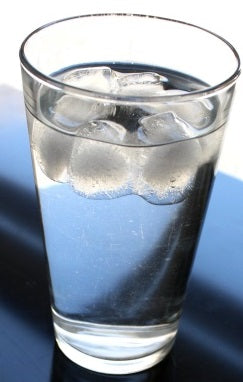20 Minute Labs: Levitating Ice Cube
MAKE ICE HOVER LIKE MAGIC!
Have you ever watched something that seemed to float or hover in the air like magic? Another word for this is levitation.

You might have seen it done with magnets - the force from one magnet can make another magnet hover above it!
If you've ever had ice water, you probably noticed that the ice floats right at the top of the glass. What if we could make it levitate right in the middle of a glass of liquid?
In this month's 20 Minute Lab, we'll do just that using the properties of density and a few materials you have around the house!
WHAT YOU'LL NEED
-
Tall glass or vase

- Canola oil (olive or vegetable oil will also work)
- Mineral oil (sometimes marketed as 'baby oil')
- 2 ice cubes
- Food coloring (optional)
LET'S GET STARTED!
Optional First Experiment:- First fill the glass 2/3 of the way with regular water.
- Add an ice cube and observe. What happens to the ice cube?
- Empty the glass of water and the cube.
-
Add a few drops of food coloring to the bottom of the glass.

- Next fill the bottom third of your glass with canola oil.
- Carefully and slowly, add the mineral oil, so it forms a layer on top of the canola oil. (We tipped the glass and ran the mineral oil slowly down the side).
- Add the ice cube and observe.
- A few minutes later, you'll notice the ice cube begin to melt - what happens to the water drops?
Troubleshooting
If your ice cube sinks to the bottom, it may be because the mineral oil was added too fast and the two oils mixed. Retry in a new glass, or perhaps wait a day until the two oils separate in your first glass.
WHAT'S GOING ON?

Why did the ice cube behave differently in water compared to the two oils? Well, it has to do with density, or how much stuff (atoms and molecules) can be packed into a given space.
Let's talk about liquid water and ice. Since they are both made from water, shouldn't they have the same density? Weirdly, no!
Ice is actually less dense than liquid water. In liquid water, the molecules are free to move as they please. Think of how you can swish and splash water around!

Ice on the other hand, is created by water molecules forming a lattice, like a 3D grid. This means the molecules are more spread out, and therefore, less dense than liquid water. This is why, when you put the ice cube into plain water, the ice cube floated to the top!
Okay, but what about in the two oils - why did the ice cube hover between the mineral oil and canola oil? Well, these liquids have different.
Mineral oil is the least dense - less dense than canola oil and ice. And the ice is less dense than canola oil. Liquid water is the most dense.
You may have noticed that, as the ice cube melted, the liquid water drops went straight to the bottom and mixed with the food coloring! That's because food coloring is mostly water too, and water, being the most dense of all the things in the glass, sinks to the bottom.
SHARE WITH US!Let us know how your experiments turned out! Share your photos and results with us on Facebook, Twitter, Instagram, or send us an email to info@yellow-scope.com. We love getting your messages!
For more exciting experiments, check out our Yellow Scope science kits on the Shop tab of our website!




Chelsea Schuyler
Author